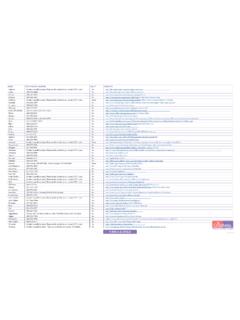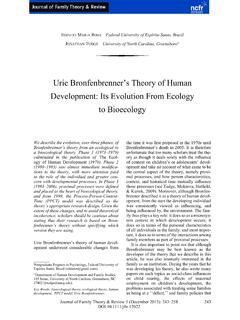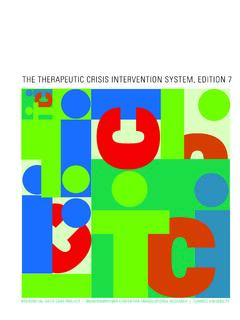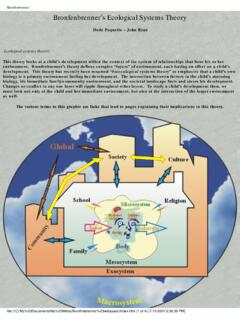Transcription of The Bioecological Model of Human Development
1 793 CHAPTER 14 The Bioecological Model ofHuman DevelopmentURIE bronfenbrenner and PAMELA A. MORRISOV E RVIEW795 DEFINING PROPERT I ES OF TH EBIOECOLOGICAL MODEL796 Proposition I797 Proposition II798 FROM TH EORY TO RESEARCH DESIGN:OPERATIONALIZING TH EBIOECOLOGICAL MODEL799 Developmental Science in the Discovery Mode801 Different Paths to Different Outcomes: Dysfunctionversus Competence803 The Role ofExperiments in the Bioecological Model808 HOW DO PERSON CHARACTERISTICS INFLUENCELATER Development ?810 Force Characteristics as Shapers of Development810 Resource Characteristics of the Person as Shapersof Development812 Demand Characteristics of the Person asDevelopmental Influences812TH E ROLE OF FOCUS OF ATTENTION INPROXIMAL PROCESSES813 PROXIMAL PROCESSES IN SOLO ACTIVITIESWITH OBJECTS AND SYMBOLS814TH E MICROSYSTEM MAGNIFIED: ACTIVITIES,RELATIONSHIPS, AND ROLES814Ef fects of the Physical Environment onPsychological Development814 The Mother-Infant Dyad as a Context of Development815 BEYOND TH E MICROSYSTEM817 The Expanding Ecological Universe818 Nature-Nurture Reconceptualized.
2 A Bioecological Interpretation819 TIME IN TH E Bioecological Model :MICRO-, MESO-, ANDMACROCHRONOLOGICAL SYSTEMS820 FROM RESEARCH TO REALITY822TH E Bioecological Model : ADEVELOPMENTAL ASSESSMENT824 REFERENCES825 The Bioecological Model , together with its correspon-ding research designs, is an evolving theoretical systemfor the scientific study of Human Development over time( bronfenbrenner , 2005). In the Bioecological Model , de-velopment is defined as the phenomenon of continuityand change in the biopsychological characteristics ofhuman beings, both as individuals and as groups. Thephenomenon extends over the life course, across succes-We are especially grateful for the thoughtful criticisms ofearlier drafts of the manuscript generously provided by thefollowing colleagues: Jay Belsky, Rick Canfield, Nancy Dar-ling, Glen H.
3 Elder Jr., Steven F. Hamilton, Melvin L. Kohn,Kurt L scher, Phyllis Moen, Donna Dempster-McLain, Lau-rence Steinberg, and Sheldon H. White. We owe particularthanks to Professor Susan Crockenberg and her students at the University of Vermont who, in the course of a graduatesive generations, and through historical time, both pastand future. The term futureraises a question: How is itpossible to scientifically investigate phenomena thathave not yet taken place? This question is hardly new;indeed, it pervades every field of scientific , we are the only species that, over historicaltime, has developed the capacity to engage successfullyin scientific inquiry, and thereby, in many respects, hasseminar, carefully reviewed a draft of this chapter, and mademany constructive suggestions.
4 We have done our best tomeet the high standards that they commendably set. We wishto express gratitude to Richard M. Lerner and WilliamDamon, the editors of the 1998 Volume and of that series as awhole, for their wise advice, encouragement, and , a special thanks goes to our most severe and mostconstructive critic, Liese Bioecological Model of Human Developmentbeen able to change the nature of the world in which welive. As a result, within certain limits, we humans havealtered the nature and course of our own Development asa species ( bronfenbrenner & Evans 2000; Bronfenbren-ner & Morris 1998).To place Bioecological theory of Human developmentinto a larger context, it is important to recognize thatmany of the general perspectives advanced and elabo-rated in this theory are also parts of other related linesof theoretical and empirical inquiry into Human devel-opment.
5 Examples include life-span psychology (Baltes,Lindenberger, & Staudinger, Chapter 11, this Handbook,this volume), cultural psychology (Cole, 1995; Shwederet al., Chapter 13, this Handbook,this volume), Magnus-son s developmental theory of contextual-interactiveholism (Magnusson & Stattin, Chapter 8, this Hand-book,this volume), and, especially, the work of RobertCairns (Chapter 3, this Handbook,this volume), whothrough communications and publications extendingover 3 decades, has played a major role in the evolutionof the four defining properties of the bioecologicalmodel: (1) Process, (2) Person, (3) Context, and (4)Time.
6 Cairns is best known as the founder and principalprotagonist of developmental science, and there are sev-eral excellent examples of his books and articles thathave been most relevant to the evolution of the bioeco-logical Model (Bergman, Cairns, Nilsson, & Nysted,2000; Cairns, 1970; Cairns & Cairns, 1994). The spe-cific profile of the Bioecological Model of Human devel-opment is its interdisciplinary and integrative focus onthe age periods of childhood and adolescence and its ex-plicit interest in applications to policies and programspertinent to enhancing youth and family this chapter, we undertake to present the ecologi-cal Model of Human Development that has been intro-duced over the course of the prior two editions of thisHandbook( bronfenbrenner & Crouter, 1983; Bronfen-brenner & Morris, 1998).
7 The main focus of the 1983chapter was on the empirical and theoretical roots of amodel already in use, which centered on the role of theenvironment in shaping Development . In contrast, thischapter is oriented toward the future. The present modelintroduces major theoretical innovations from the 1983chapter in both form and content. The present formula-tion makes no claim as a paradigm shift (if there be sucha phenomenon); rather, it continues a marked shift in thecenter of gravity of the Model , in which features of ear-lier versions are first called into question but then re-combined, along with new elements, into a more com-plex and more dynamic transition in the form and content of the modelactually took place over an extended period of time, anexpression that will become all too familiar to the reader( bronfenbrenner , 2005).
8 The transition from a focus onthe environment to a focus on processes was first intro-duced in the context of bronfenbrenner s unpublishedlectures, colloquium presentations, and contributionsto symposia. Not until 1986, did reference to an emer-gent new Model first appear in print ( bronfenbrenner ,1986b). The following extended excerpt conveys both itsspirit and intended substance. Because both of these at-tributes are relevant to the gradual evolution of themodel to its present form, we quote from the 1986 state-ment at some length:It is now more than a decade ago that, being somewhatyounger, I presumed to challenge the then-prevailing con-ventions of our field by describing the developmental re-search of the day as the study of the strange behavior ofchildren in strange situations for the briefest possible pe-riod of time ( bronfenbrenner , 1974).
9 Instead, I argued (asif it were simply a matter of choice), we should be studyingdevelopment in its ecological context; that is, in the actualenvironments in which Human beings lived their lives. Ithen proceeded to outline, in a series of publications, a con-ceptual framework for analyzing Development in context,and to offer concrete examples of how various elements ofthe schema might be applied both to past studies and tostudies yet-to-come. I also emphasized the scientific andpractical benefits of a closer linkage, in both directions, be-tween developmental research and public policy (Bronfen-brenner, 1974, 1975, 1977a, 1977b, 1979a, 1979b, 1981).
10 Now, a dozen years later, one might think that I have goodreason to rest content. Studies of children and adults inreal-life settings, with real-life implications, are now com-monplace in the research literature on Human Development ,both in the United States and, as this volume testifies, inEurope as well. This scientific Development is taking place,I believe, not so much because of my writings, but ratherbecause the notions I have been promulgating are ideaswhose time has come..Clearly, if one regards such scientific developments asdesirable, there are grounds for satisfaction. Yet, alongwith feelings of gratification, I must confess to some dis-content.






